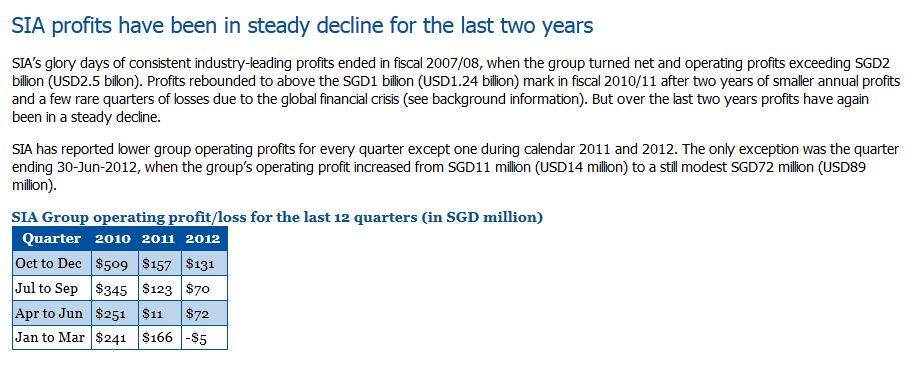Originally Posted by Romulus "in the short term yes. In the longer term as your competition senses that you can't defend yourself and your position then they get more ferocious about going after you. Absolute numbers are growing, and if Qantas don't capture them to the same percentage then the opposition will and that will embolden them to go even harder."
Well said! SIA (amongst others) will be working overtime to gain market share, not sure Qantas is in any position to fight back fleet wise in the short term.


Lessons from the past says it is easier to dismantle but much harder to rebuild, I think the Q CEO has dug a huge hole for himself, (a mining industry sized hole.)
Qantas cost figures remain under question | Plane Talking
A quizzical look at some of the figures in the Qantas first half financials
The view that Qantas has massaged the financial performance of its loss making full service international operations to suit an ideological agenda to marginalise if not exit a large part of them while favouring Jetstar by making it carry some of its costs have been around for a long time.
They have also been denied for a long time by management.
However the implication of a review of its first half FY13 results, which were released last Thursday, is that some of the costings are possibly wrong, and being ‘managed’ to a schedule by which a much reduced international division could be deemed to have become viable by 2015, by which time there won’t be nearly as much of it left as there is today.
By 2015 Qantas might only be flying from Sydney and Melbourne to Dubai, where its passengers will transfer to Emirates flights for onward connections, while in the rest of Australia, under the Qantas-Emirates partnership, Qantas will expect whatever customers it still has over this cities to fly all the way on Emirates, not to mention those who already do so from Sydney or Melbourne anyhow
and
The other key international operations will be to Singapore and Hong Kong, for mid-trip connections to the Jetstar franchise connections deeper into Asia, and to Los Angeles and Dallas Fort Worth, and to Santiago and Johannesburg.
Qantas has actively encouraged most of these predictions already, with group CEO Alan Joyce last Thursday talking up the Qantas/Jetstar connections in Asia, which begged the unasked question as to why Qantas customers would bother when the real choice would be going all the way on Jetstar, or going all the way on Singapore Airlines or Cathay Pacific flights with a vast number of full service onward connections on SilkAir or the soon to be rebranded Cathay Dragon.
This is what the ‘ginger group’ notes on the first half FY13 figures says, in part:
1. How did Qantas International achieve a 9.1% ($254M) reduction in operating costs (including fuel) in 6 months compared to 1H12, noting that Qantas Group operating costs increased by 2.9%? With regard to fuel costs, the 1H13 results state that the fuel cost was $2181M in both 1H13 and 1H12 indicating that fuel costs have been unchanged. The reduction in operating costs must therefore have come about in other expense categories. Given there has been no significant change in Qantas International’s workforce, the reduction cannot be attributed to a large drop in employment.
2. How can one part of the business incur substantial cost increases and yet another part of the business incur a very sizeable cost reduction? Qantas Domestic costs increased by 6.4% including fuel (which is a non-issue) but Qantas International’s costs decreased by 9.1%. Both these businesses employ very similar types of resources (engineering, maintenance, labour) and use similar inputs. Aircraft operating lease rentals and depreciation are not included in these costfigures so there is possible explanation there.
3. Qantas International Segment Revenue and Other income decreased by 3.5%. With a reduction in revenue, there is less scope to improve the underlying EBIT. To achieve a smaller loss in the context of declining revenue requires an even greater reduction in operating costs. And this is exactly what has happened if one is to believe the 1H13 results. If one was trying to engineer a turn-around in Qantas International, one would need to “produce” a very large cost reduction in the face of declining revenue.
4. Perhaps a reduction in Qantas International capacity is the answer? According to the 1H13 results, Qantas International reduced capacity by 7%. However this capacity reduction cannot translate into anywhere near a 7% reduction in operating costs as many of Qantas costs are fixed costs that cannot be varied in the short run (eg labour).
Whilst some of the cost reduction can be attributable to reduced capacity such as reduced fuel costs, perhaps it is in the order of 3-4%, nowhere near the 9% cost reduction purported in the 1H13 results.
In summary, the 9.1% reduction in Qantas International’s operating costs seems incredulous in light of (i) an increase in Qantas Group costs and a sizable increase in Qantas Domestic Costs (ii) relatively constant fuel prices and a strong Australian dollar (reducing the AUD cost of fuel) and (iii) declining revenue.
What is interesting is that none of the commentary I’ve seen has focused on Qantas International’s “amazing” cost reduction achievement. Nor did Alan Joyce point to it at all. If the cost reduction were the real thing, they would be singing out loud and clear about it.